airbag HONDA CIVIC COUPE 1999 Owner's Manual
[x] Cancel search | Manufacturer: HONDA, Model Year: 1999, Model line: CIVIC COUPE, Model: HONDA CIVIC COUPE 1999Pages: 269, PDF Size: 2.42 MB
Page 40 of 269
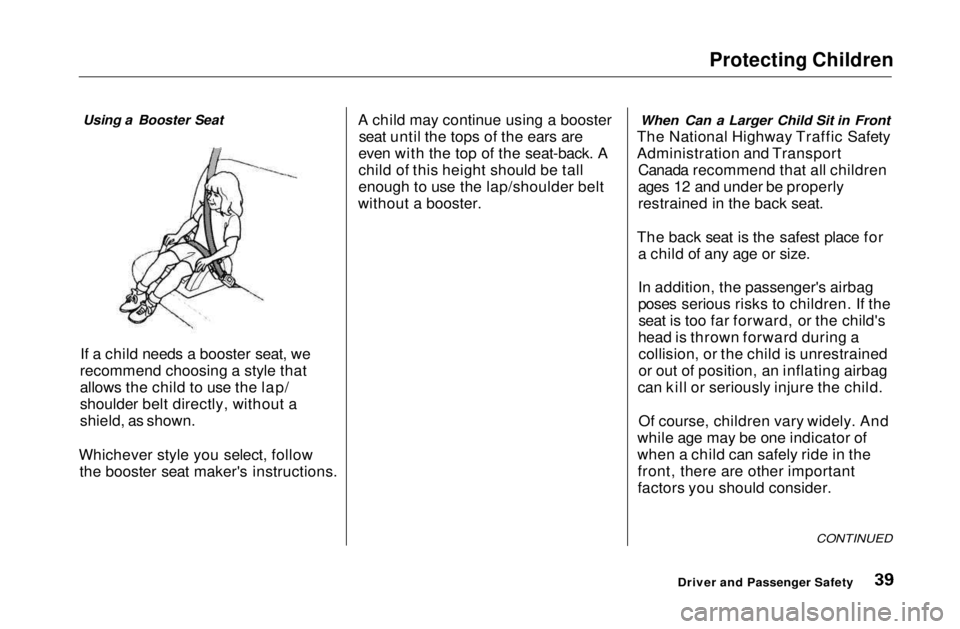
Protecting Children
Using a Booster Seat
If a child needs a booster seat, we
recommend choosing a style that
allows the child to use the lap/
shoulder belt directly, without a
shield, as shown.
Whichever style you select, follow the booster seat maker's instructions. A child may continue using a booster
seat until the tops of the ears are
even with the top of the seat-back. A
child of this height should be tall
enough to use the lap/shoulder belt
without a booster.
When Can a Larger Child Sit in Front
The National Highway Traffic Safety
Administration and Transport Canada recommend that all children
ages 12 and under be properly
restrained in the back seat.
The back seat is the safest place for a child of any age or size.
In addition, the passenger's airbag
poses serious risks to children. If theseat is too far forward, or the child's
head is thrown forward during a collision, or the child is unrestrained
or out of position, an inflating airbag
can kill or seriously injure the child.
Of course, children vary widely. And
while age may be one indicator of
when a child can safely ride in the front, there are other important
factors you should consider.
CONTINUED
Driver and Passenger SafetyMain Menu Table of Contents s t
Page 46 of 269
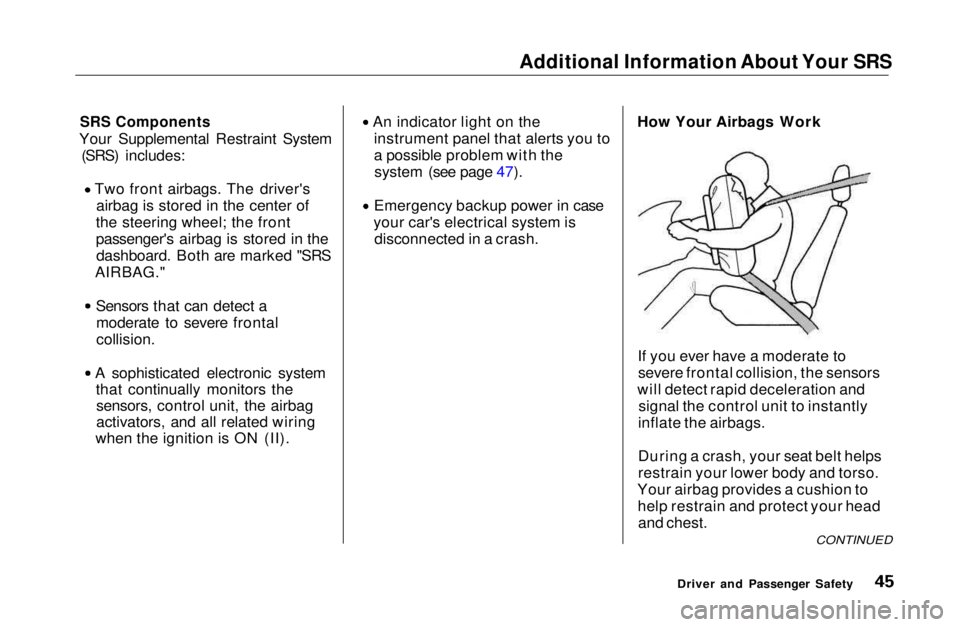
Additional Information About Your SRS
SRS Components
Your Supplemental Restraint System (SRS) includes: Two front airbags. The driver's
airbag is stored in the center of
the steering wheel; the front
passenger's airbag is stored in the dashboard. Both are marked "SRS
AIRBAG." Sensors that can detect a
moderate to severe frontal
collision. A sophisticated electronic system
that continually monitors thesensors, control unit, the airbag
activators, and all related wiring
when the ignition is ON (II). An indicator light on the
instrument panel that alerts you to
a possible problem with thesystem (see page 47). Emergency backup power in case
your car's electrical system is disconnected in a crash. How Your Airbags Work
If you ever have a moderate tosevere frontal collision, the sensors
will detect rapid deceleration and signal the control unit to instantly
inflate the airbags.
During a crash, your seat belt helps
restrain your lower body and torso.
Your airbag provides a cushion to help restrain and protect your headand chest.
Driver and Passenger Safety
CONTINUEDMain Menu Table of Contents s t
Page 47 of 269
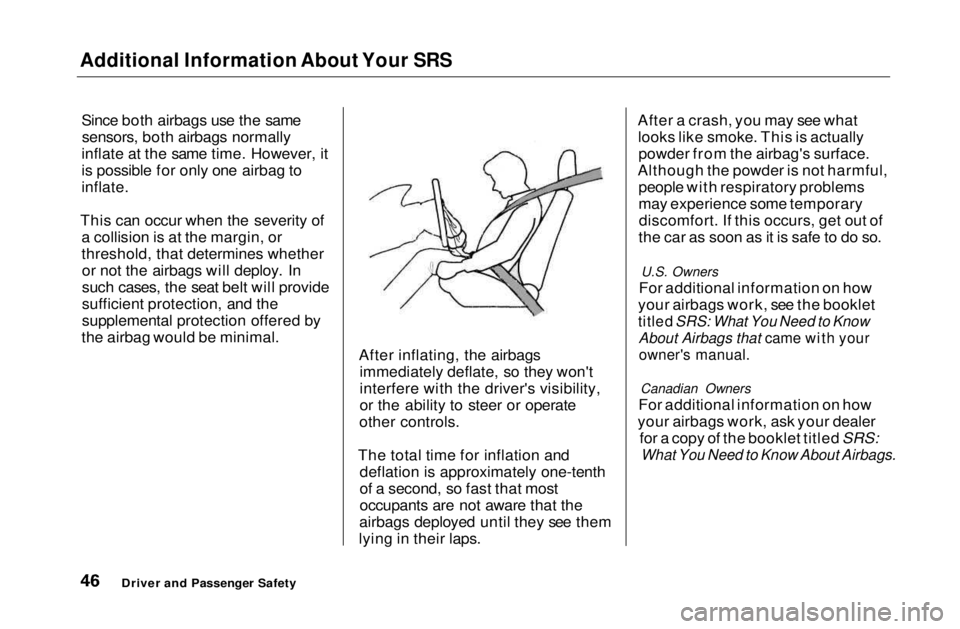
Additional Information About Your SRS
Since both airbags use the samesensors, both airbags normally
inflate at the same time. However, it
is possible for only one airbag to
inflate.
This can occur when the severity of a collision is at the margin, or
threshold, that determines whetheror not the airbags will deploy. In
such cases, the seat belt will provide
sufficient protection, and the
supplemental protection offered by
the airbag would be minimal.
After inflating, the airbagsimmediately deflate, so they won't
interfere with the driver's visibility,
or the ability to steer or operate
other controls.
The total time for inflation and deflation is approximately one-tenth
of a second, so fast that most
occupants are not aware that the
airbags deployed until they see them
lying in their laps. After a crash, you may see what
looks like smoke. This is actuallypowder from the airbag's surface.
Although the powder is not harmful, people with respiratory problems
may experience some temporarydiscomfort. If this occurs, get out of
the car as soon as it is safe to do so.
U.S. Owners
For additional information on how
your airbags work, see the booklet
titled SRS: What You Need to Know About Airbags that came with your
owner's manual.
Canadian Owners
For additional information on how
your airbags work, ask your dealer for a copy of the booklet titled SRS:
What You Need to Know About Airbags.
Driver and Passenger SafetyMain Menu Table of Contents s t
Page 48 of 269
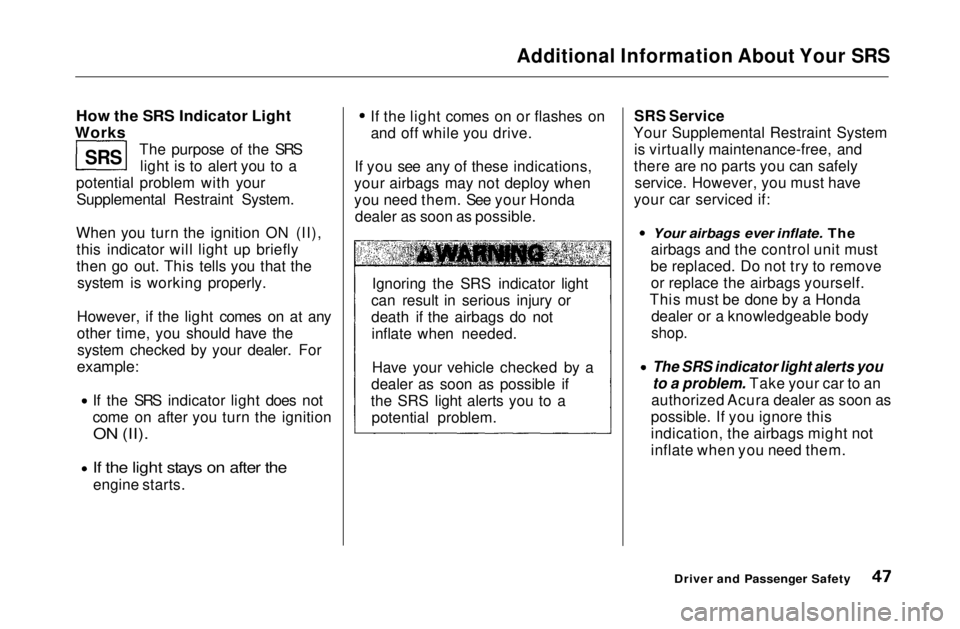
Additional Information About Your SRS
How the SRS Indicator Light
Works
The purpose of the SRSlight is to alert you to a
potential problem with your Supplemental Restraint System.
When you turn the ignition ON (II), this indicator will light up briefly
then go out. This tells you that the system is working properly.
However, if the light comes on at any
other time, you should have the system checked by your dealer. For
example:
If the SRS indicator light does not
come on after you turn the ignition
ON (II). If the light stays on after the
engine starts. If the light comes on or flashes on
and off while you drive.
If you see any of these indications,
your airbags may not deploy when
you need them. See your Honda dealer as soon as possible. SRS Service
Your Supplemental Restraint System is virtually maintenance-free, and
there are no parts you can safely service. However, you must have
your car serviced if:
Your airbags ever inflate. The
airbags and the control unit must
be replaced. Do not try to remove or replace the airbags yourself.
This must be done by a Honda dealer or a knowledgeable body
shop.
The SRS indicator light alerts you
to a problem. Take your car to an
authorized Acura dealer as soon as
possible. If you ignore this
indication, the airbags might not
inflate when you need them.
Driver and Passenger Safety
SRS
Ignoring the SRS indicator light
can result in serious injury or
death if the airbags do not inflate when needed.
Have your vehicle checked by a
dealer as soon as possible if
the SRS light alerts you to a potential problem.Main Menu Table of Contents s t
Page 49 of 269
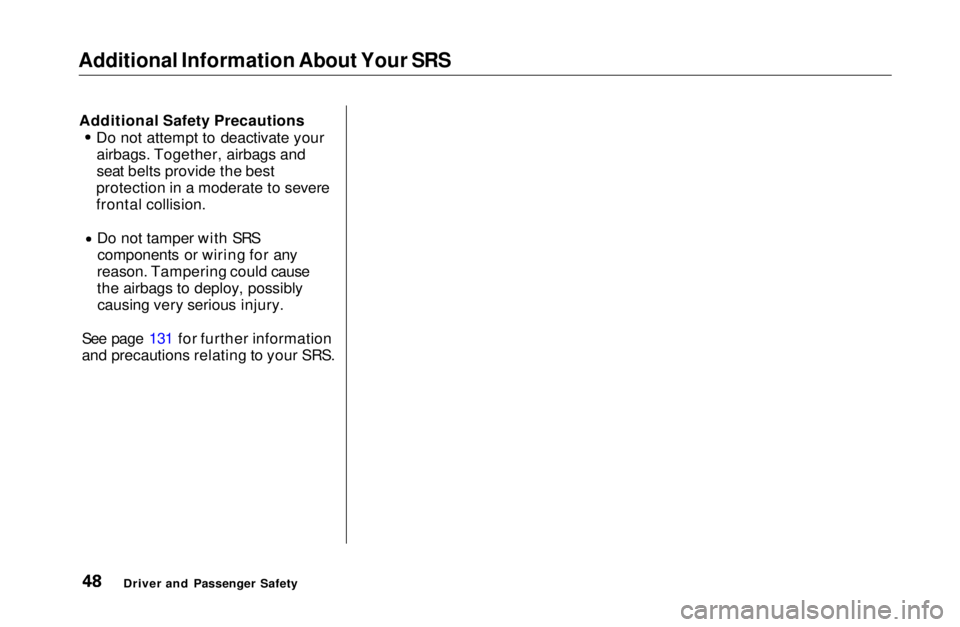
Additional Information About Your SRS
Additional Safety Precautions Do not attempt to deactivate your
airbags. Together, airbags and
seat belts provide the best
protection in a moderate to severe
frontal collision. Do not tamper with SRS
components or wiring for any
reason. Tampering could cause
the airbags to deploy, possibly causing very serious injury.
See page 131 for further information
and precautions relating to your SRS.
Driver and Passenger SafetyMain Menu Table of Contents s t
Page 130 of 269
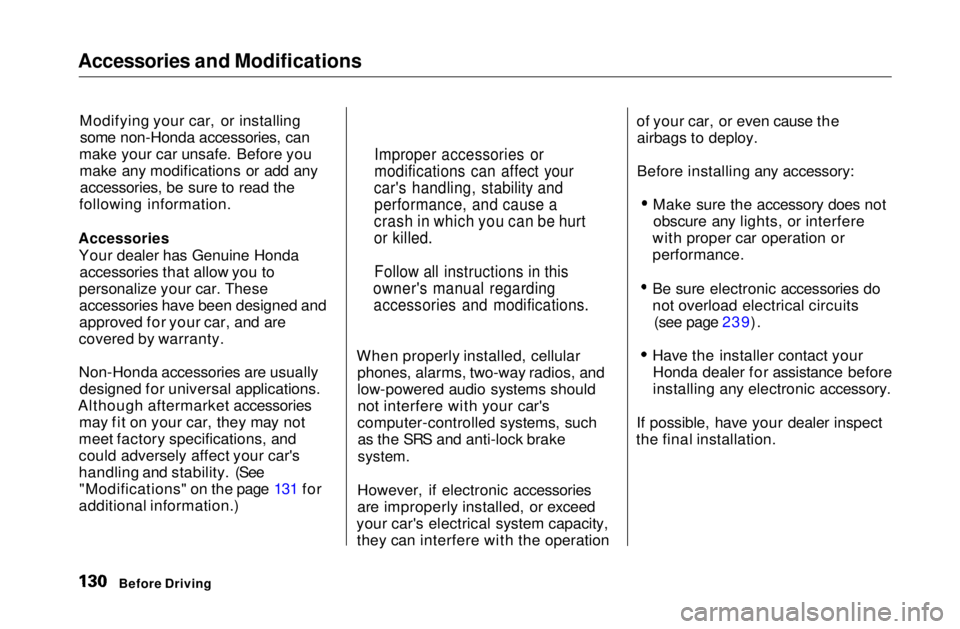
Accessories and Modifications
Modifying your car, or installingsome non-Honda accessories, can
make your car unsafe. Before you make any modifications or add anyaccessories, be sure to read the
following information.
Accessories
Your dealer has Genuine Honda accessories that allow you to
personalize your car. These accessories have been designed and
approved for your car, and are
covered by warranty.
Non-Honda accessories are usually designed for universal applications.
Although aftermarket accessories may fit on your car, they may not
meet factory specifications, and
could adversely affect your car's
handling and stability. (See "Modifications" on the page 131 for
additional information.) When properly installed, cellular
phones, alarms, two-way radios, and
low-powered audio systems shouldnot interfere with your car's
computer-controlled systems, such as the SRS and anti-lock brake
system.
However, if electronic accessories
are improperly installed, or exceed
your car's electrical system capacity, they can interfere with the operation of your car, or even cause the
airbags to deploy.
Before installing any accessory:
Make sure the accessory does notobscure any lights, or interfere
with proper car operation or
performance.
Be sure electronic accessories do
not overload electrical circuits (see page 239). Have the installer contact your
Honda dealer for assistance before
installing any electronic accessory.
If possible, have your dealer inspect
the final installation.
Before Driving
Improper accessories or
modifications can affect your
car's handling, stability and performance, and cause a
crash in which you can be hurt
or killed.
Follow all instructions in this
owner's manual regarding accessories and modifications.Main Menu Table of Contents s t
Page 131 of 269

Accessories and Modifications
Modifications Do not remove any original
equipment or modify your car in any
way that would alter its design or operation. This could make your car
unsafe and illegal to drive.
For example, do not make any
modifications that would change the
ride height of your car, or install
wheels and tires with a different overall diameter.
Such modifications can adversely
affect handling, and interfere with
the operation of the car's anti-lock
brakes and other systems. In addition, any modifications that
decrease ground clearance increase
the chance of undercarriage parts striking a curb, speed bump, or other
raised object, which could cause
your airbags to deploy.
Do not modify your steering wheelor any other part of your
Supplemental Restraint System.
Modifications could make the
system ineffective. Additional Safety Precaution
Do not attach or place objects on the
airbag covers. Any object attached to
or placed on the covers marked "SRS
AIRBAG," in the center of the steering wheel and on top of the
dashboard, could interfere with the
proper operation of the airbags. Or,
if the airbags inflate, the objects
could be propelled inside the car and
hurt someone.
Before DrivingMain Menu Table of Contents s t
Page 260 of 269
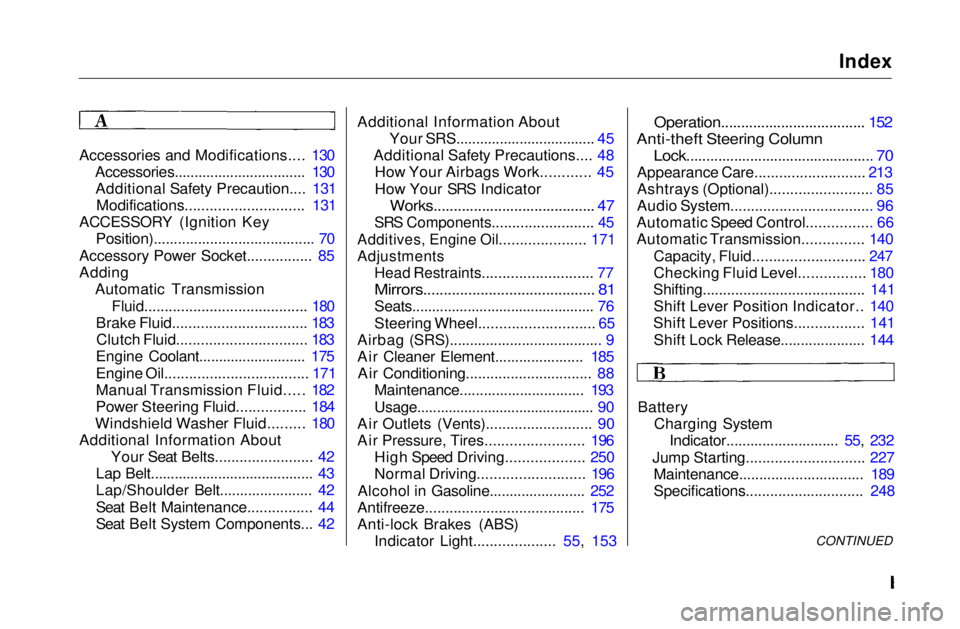
Index
Accessories and Modifications.... 130 Accessories................................. 130Additional Safety Precaution.... 131 Modifications............................. 131
ACCESSORY (Ignition Key Position)........................................ 70
Accessory Power Socket................ 85
Adding Automatic Transmission
Fluid........................................ 180
Brake Fluid................................. 183 Clutch Fluid................................ 183
Engine Coolant........................... 175
Engine Oil................................... 171
Manual Transmission Fluid..... 182
Power Steering Fluid................. 184
Windshield Washer Fluid......... 180
Additional Information About Your Seat Belts........................ 42
Lap Belt......................................... 43
Lap/Shoulder Belt....................... 42
Seat Belt Maintenance................ 44
Seat Belt System Components... 42 Additional Information About
Your SRS................................... 45
Additional Safety Precautions.... 48 How Your Airbags Work............ 45
How Your SRS Indicator
Works........................................ 47
SRS Components......................... 45
Additives, Engine Oil..................... 171
Adjustments
Head Restraints........................... 77
Mirrors.......................................... 81
Seats.............................................. 76
Steering Wheel............................ 65
Airbag (SRS)...................................... 9
Air Cleaner Element...................... 185 Air Conditioning............................... 88 Maintenance............................... 193
Usage............................................. 90
Air Outlets (Vents).......................... 90
Air Pressure, Tires........................ 196 High Speed Driving................... 250
Normal Driving.......................... 196
Alcohol in Gasoline........................ 252
Antifreeze....................................... 175
Anti-lock Brakes (ABS) Indicator Light.................... 55, 153
Operation.................................... 152
Anti-theft Steering Column
Lock............................................... 70
Appearance Care........................... 213
Ashtrays (Optional)......................... 85
Audio System................................... 96
Automatic Speed Control................ 66
Automatic Transmission............... 140
Capacity, Fluid........................... 247
Checking Fluid Level................ 180
Shifting........................................ 141
Shift Lever Position Indicator.. 140
Shift Lever Positions................. 141
Shift Lock Release..................... 144
Battery Charging SystemIndicator............................ 55, 232
Jump Starting............................. 227 Maintenance............................... 189
Specifications............................. 248
CONTINUEDMain Menu s t
Page 266 of 269
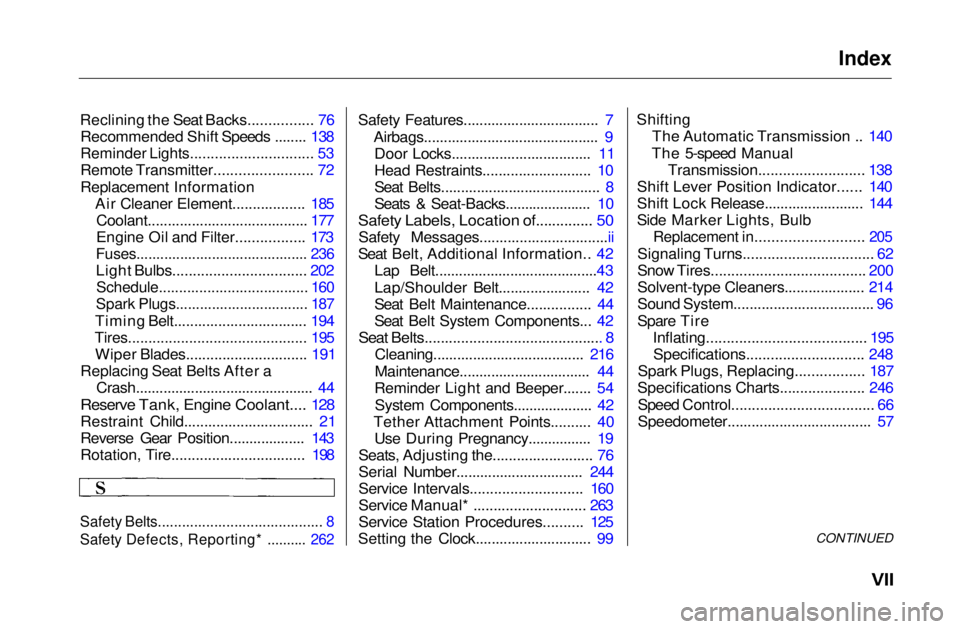
Index
Reclining the Seat Backs................ 76 Recommended Shift Speeds ........ 138
Reminder Lights.............................. 53
Remote Transmitter........................ 72
Replacement Information Air Cleaner Element.................. 185Coolant........................................ 177
Engine Oil and Filter................. 173
Fuses........................................... 236
Light Bulbs................................. 202
Schedule..................................... 160
Spark Plugs................................. 187
Timing Belt................................. 194
Tires............................................ 195
Wiper Blades.............................. 191
Replacing Seat Belts After a Crash............................................. 44
Reserve Tank, Engine Coolant.... 128
Restraint Child................................ 21
Reverse Gear Position................... 143
Rotation, Tire................................. 198
Safety Belts......................................... 8
Safety Defects, Reporting* .......... 262
Safety Features.................................. 7
Airbags............................................ 9Door Locks................................... 11
Head Restraints........................... 10
Seat Belts........................................ 8
Seats & Seat-Backs...................... 10
Safety Labels, Location of.............. 50
Safety Messages................................ii
Seat Belt, Additional Information.. 42 Lap Belt.........................................43
Lap/Shoulder Belt....................... 42
Seat Belt Maintenance................ 44
Seat Belt System Components... 42
Seat Belts............................................ 8
Cleaning...................................... 216
Maintenance................................. 44
Reminder Light and Beeper....... 54
System Components.................... 42
Tether Attachment Points.......... 40 Use During Pregnancy................ 19
Seats, Adjusting the......................... 76
Serial Number................................ 244
Service Intervals............................ 160
Service Manual* ............................ 263
Service Station Procedures.......... 125
Setting the Clock............................. 99 Shifting
The Automatic Transmission .. 140
The 5-speed Manual Transmission.......................... 138
Shift Lever Position Indicator...... 140
Shift Lock Release......................... 144
Side Marker Lights, Bulb
Replacement in.......................... 205
Signaling Turns................................ 62
Snow Tires...................................... 200
Solvent-type Cleaners.................... 214
Sound System................................... 96
Spare Tire Inflating....................................... 195Specifications............................. 248
Spark Plugs, Replacing................. 187
Specifications Charts..................... 246
Speed Control................................... 66
Speedometer.................................... 57
CONTINUEDMain Menu s t
Page 267 of 269
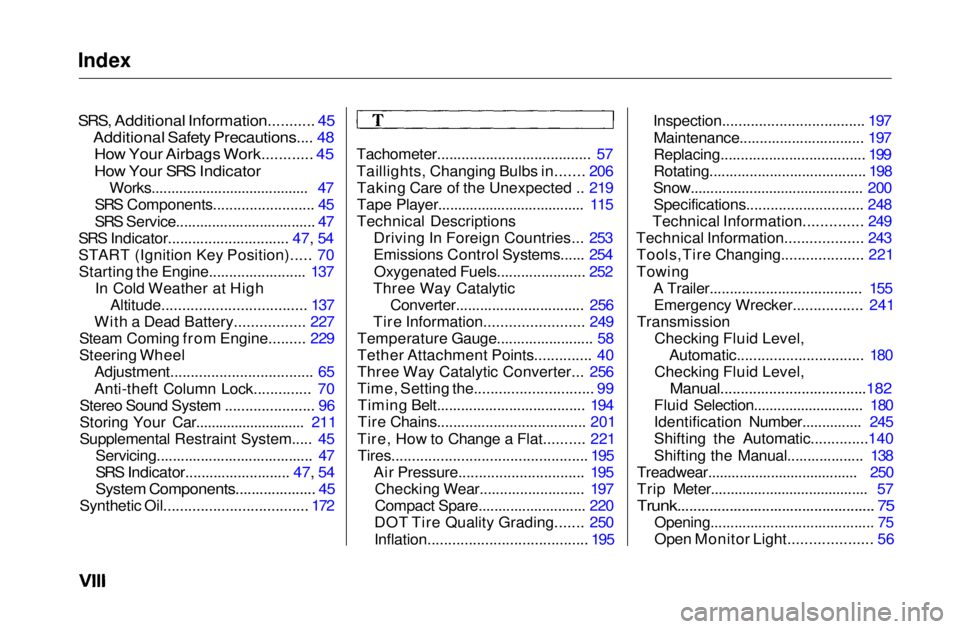
Index
SRS, Additional Information........... 45
Additional Safety Precautions.... 48
How Your Airbags Work............ 45
How Your SRS Indicator
Works........................................ 47
SRS Components......................... 45
SRS Service................................... 47
SRS Indicator.............................. 47, 54
START (Ignition Key Position)..... 70 Starting the Engine........................ 137 In Cold Weather at HighAltitude................................... 137
With a Dead Battery................. 227
Steam Coming from Engine......... 229
Steering Wheel
Adjustment................................... 65
Anti-theft Column Lock.............. 70
Stereo Sound System ...................... 96
Storing Your Car............................ 211
Supplemental Restraint System..... 45 Servicing....................................... 47
SRS Indicator.......................... 47, 54
System Components.................... 45
Synthetic Oil................................... 172 Tachometer...................................... 57
Taillights, Changing Bulbs in....... 206
Taking Care of the Unexpected .. 219
Tape Player..................................... 115
Technical Descriptions Driving In Foreign Countries... 253
Emissions Control Systems...... 254
Oxygenated Fuels...................... 252
Three Way Catalytic Converter................................ 256
Tire Information........................ 249
Temperature Gauge........................ 58
Tether Attachment Points.............. 40
Three Way Catalytic Converter... 256
Time, Setting the............................. 99
Timing Belt..................................... 194
Tire Chains..................................... 201
Tire, How to Change a Flat.......... 221 Tires................................................ 195 Air Pressure............................... 195Checking Wear.......................... 197
Compact Spare........................... 220
DOT Tire Quality Grading....... 250
Inflation....................................... 195 Inspection................................... 197
Maintenance............................... 197
Replacing.................................... 199
Rotating....................................... 198
Snow............................................ 200 Specifications............................. 248
Technical Information.............. 249
Technical Information................... 243 Tools,Tire Changing.................... 221
Towing A Trailer...................................... 155Emergency Wrecker................. 241
Transmission Checking Fluid Level,Automatic............................... 180
Checking Fluid Level,
Manual....................................182
Fluid Selection............................ 180
Identification Number............... 245
Shifting the Automatic..............140
Shifting the Manual................... 138
Treadwear...................................... 250
Trip Meter........................................ 57
Trunk................................................. 75
Opening......................................... 75
Open Monitor Light.................... 56Main Menu s t